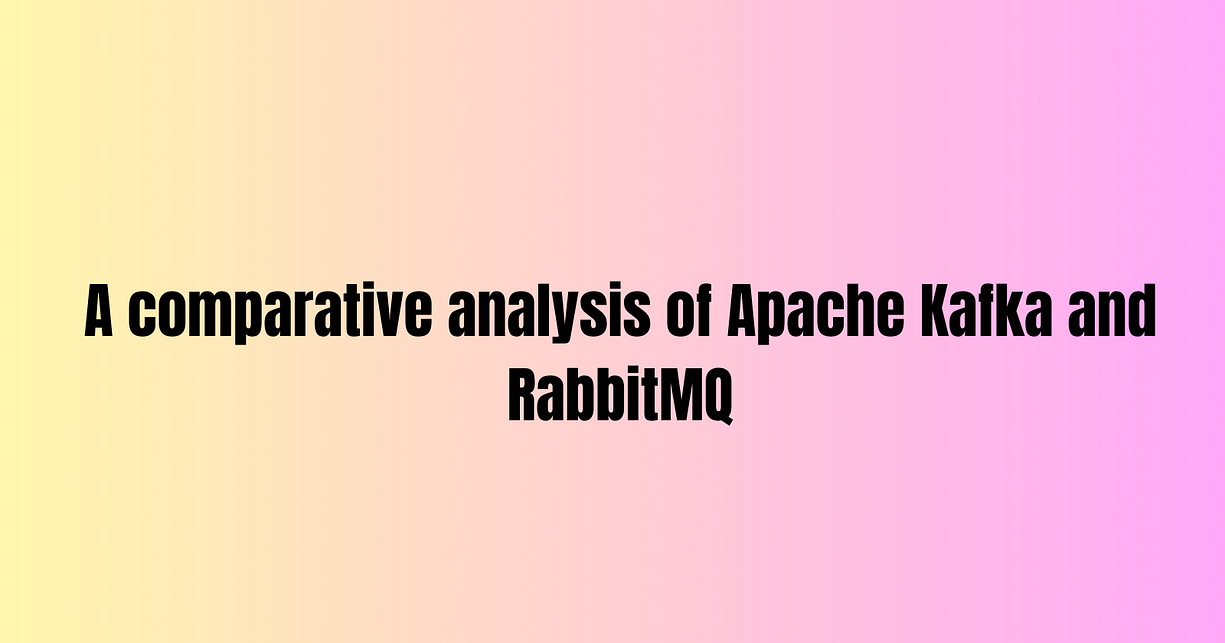A Comparative Analysis of Apache Kafka and RabbitMQ
 Felicia Sephodi
Felicia Sephodi
This article dives into the unique uses of Apache Kafka and RabbitMQ, two powerful messaging systems. We’ll explore how Apache Kafka excels in real-time event streaming, log aggregation, and making data integration and ETL pipelines a breeze. On the other side, we’ll uncover how RabbitMQ shines in tasks like efficient message queuing, smart workload distribution, and seamless support for Pub/Sub messaging patterns. By zooming in on these practical applications, whether you’re navigating real-time events or managing workloads, this article aims to give you a clear picture of what each platform does best. Let’s explore them!
Apache Kafka and RabbitMQ are both powerful messaging systems, but they serve distinct purposes in the domain of distributed systems.
Apache Kafka: Kafka is more than just a message broker; it’s a distributed streaming platform designed for handling real-time data feeds. It excels at managing large-scale, high-throughput, fault-tolerant data streams.
RabbitMQ: RabbitMQ, on the other hand, is a traditional message broker that focuses on reliable message queuing between applications. It supports various messaging patterns and ensures messages are delivered efficiently.
Differentiating between distributed streaming platform and message broker
While both Kafka and RabbitMQ facilitate communication between applications, their core functionalities and design philosophies set them apart.
A distributed streaming platform like Kafka is tailored for handling continuous streams of data, allowing applications to react to events in real-time.
A message broker like RabbitMQ, on the other hand, is designed for asynchronous communication, decoupling producers and consumers through queues.
Use Cases
Kafka
- Real-time event streaming
Kafka shines in scenarios where real-time data streams are crucial, enabling applications to process and react to events instantly.
2. Log aggregation
It serves as a robust solution for aggregating and managing log data from multiple sources, offering a centralized repository for analytics and monitoring.
3. Data integration and ETL pipelines
Kafka facilitates the seamless integration of disparate data sources, making it ideal for building efficient Extract, Transform, Load (ETL) pipelines.
RabbitMQ
- Message queuing
RabbitMQ excels in scenarios where reliable message queuing and asynchronous communication are essential for decoupling components.
2. Workload distribution
It efficiently distributes tasks across multiple consumers, ensuring balanced workloads and improved system performance.
3. Pub/Sub messaging patterns
RabbitMQ supports Publish/Subscribe patterns, enabling multiple subscribers to receive messages from a single publisher.
Scalability
Kafka
- Horizontal scalability
Kafka’s architecture allows for easy scaling horizontally by adding more broker nodes, ensuring seamless growth as data volumes increase.
2. Partitioning for parallel processing
Partitioning enables parallel processing of data across multiple nodes, improving throughput and performance.
3. Efficient handling of large datasets
Kafka’s design is optimized for handling large datasets, making it suitable for scenarios requiring massive data streams.
RabbitMQ
- Vertical scalability
RabbitMQ scales vertically by enhancing the capacity of a single node. While effective, this approach has limitations compared to Kafka’s horizontal scalability.
2. Queue-based distribution
RabbitMQ distributes workloads by dividing them into queues, but it may face challenges when dealing with extremely large datasets or high-throughput scenarios.
3. Limitations handling massive data streams
RabbitMQ may encounter performance limitations when dealing with massive and continuous data streams compared to Kafka.
Data Delivery Guarantees
Kafka
- At-least-once semantics
Kafka ensures that messages are delivered at least once, even in the presence of failures.
2. Exactly-once semantics with proper configuration
With the right configuration, Kafka can achieve exactly-once semantics, providing strict message delivery guarantees.
3. High durability and fault tolerance
Kafka’s replication mechanisms and fault tolerance features contribute to high data durability and system resilience.
RabbitMQ
- At-most-once semantics by default
RabbitMQ delivers messages at most once by default, without any additional configuration.
2. Guarantees improved with persistence settings
Message persistence settings can be configured to enhance delivery guarantees in RabbitMQ.
3. Limited to the capabilities of underlying storage mechanisms
RabbitMQ’s delivery guarantees are influenced by the capabilities of the underlying storage systems.
To wrap up…
Kafka and RabbitMQ cater to different needs within the domain of distributed systems. Kafka, as a distributed streaming platform, excels in handling massive, real-time data streams with horizontal scalability and robust delivery guarantees; however, RabbitMQ, as a traditional message broker, shines in scenarios where reliable message queuing, workload distribution, and Pub/Sub messaging patterns are paramount.
Consideration factors for choosing between Kafka and RabbitMQ based on use case, scalability, and data delivery requirements
When choosing between Kafka and RabbitMQ, developers should consider their specific use case, scalability requirements, and data delivery preferences. If real-time event streaming, log aggregation, or handling large datasets is crucial, Kafka is likely the better choice. On the other hand, if reliable message queuing, workload distribution, or Pub/Sub patterns are the primary focus, RabbitMQ may be the more suitable option.
Understanding the strengths and complexities of Kafka and RabbitMQ empowers developers to make informed decisions that align with their project requirements. Both tools contribute significantly to the open-source ecosystem, providing robust solutions for diverse messaging needs.
Subscribe to my newsletter
Read articles from Felicia Sephodi directly inside your inbox. Subscribe to the newsletter, and don't miss out.
Written by

Felicia Sephodi
Felicia Sephodi
I'm a Software Developer and Technical Writer, I am passionate about explaining complex technical concepts, why documentation matters as well as why developers should care about documentation. As of recent I realized that I enjoy working with data in the frontend, it is probably not my final destination because tech has an array of possibilities. Whenever I am not reading documentation, researching or coding I like to play tennis and watch true crime documentaries.